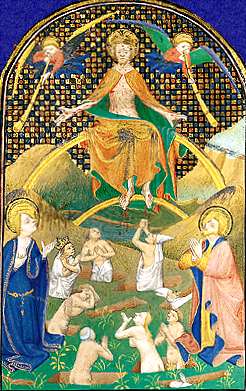
The Last Judgment
French (Paris), Circa 1400
Tempera and gold on vellum, 3¾ x 2½ in. (9.5 x 6.3 cm.)
Metropolitan Museum of Art, Gift of Max Falk, in honor of William D. Wixom, 1998.179
This illumination accompanies the "Seven Requests of Our Lord," a common inclusion in books of hours at the time. The sixth of these requests is "Dear Lord God, have pity on me in honor and remembrance of when you looked upon your mother and your disciple in the great pain of death that you suffered for us."1 In the image, the "mother and disciple," the Virgin Mary and St. John the Evangelist, stand left and right and join in supplication with the persons rising from their graves. Mary's exposed breast is unusual in images of this type, but not unique; see this example.
Aside from the inclusion of Mary and John, the image follows a number of details in the Book of Revelation. Christ is shown seated on a rainbow above a sea, as in Revelation 4: "there was a rainbow round about the throne.… And in the sight of the throne was, as it were, a sea of glass like to crystal" (4:3,6). The trumpeting angels recall the seven trumpets in chapters 8-11, especially the seventh, which signals "the time of the dead, that they should be judged" (11:18). Juxtaposed with the splendor of these images is the woeful condition of Christ's body, which continues to bleed from the five wounds, a reminder of "the great pain" of the sixth request. From that tortured body his blood flows upon the figures in white robes below, a reference to those who "have washed their robes, and have made them white in the blood of the Lamb" (7:14).
Being about supplication, the illumination differs from the "Dance of Death" images and literature of the period. In that genre there will be a saved king and a damned king, a saved pope and a damned pope, etc. But here all the figures join together in prayer, raising their hands to Christ in supplication. The white-robed pope, king, and commoner represent the three estates of society. The reader who speaks the prayer is also among the supplicants, as emphasized by the strongly vertical composition and the grave in the lower right corner whose occupant has not yet emerged.
Read more about the Last Judgment.
Source: Metropolitan Museum of Art
1 Barbara Drake Boehm, "The Last Judgment, from a Book of Hours." The Metropolitan Museum of Art Bulletin, 57, 2 (Fall 1999), 19. The sixth request is my translation from the Paris BN Ms.lat. 1156A fol.97, online as of 2020-03-18 at this page at the CHD Institute for Studies of Illuminated Manuscripts in Denmark. The original reads, "Biau sire dieu, regardes moy en pitié en lonneur et en la remambrance de celui regard dont vous regardastes vostre mère et vostre disciple en la grant tristesse de la mort que vous souffries pour nous."